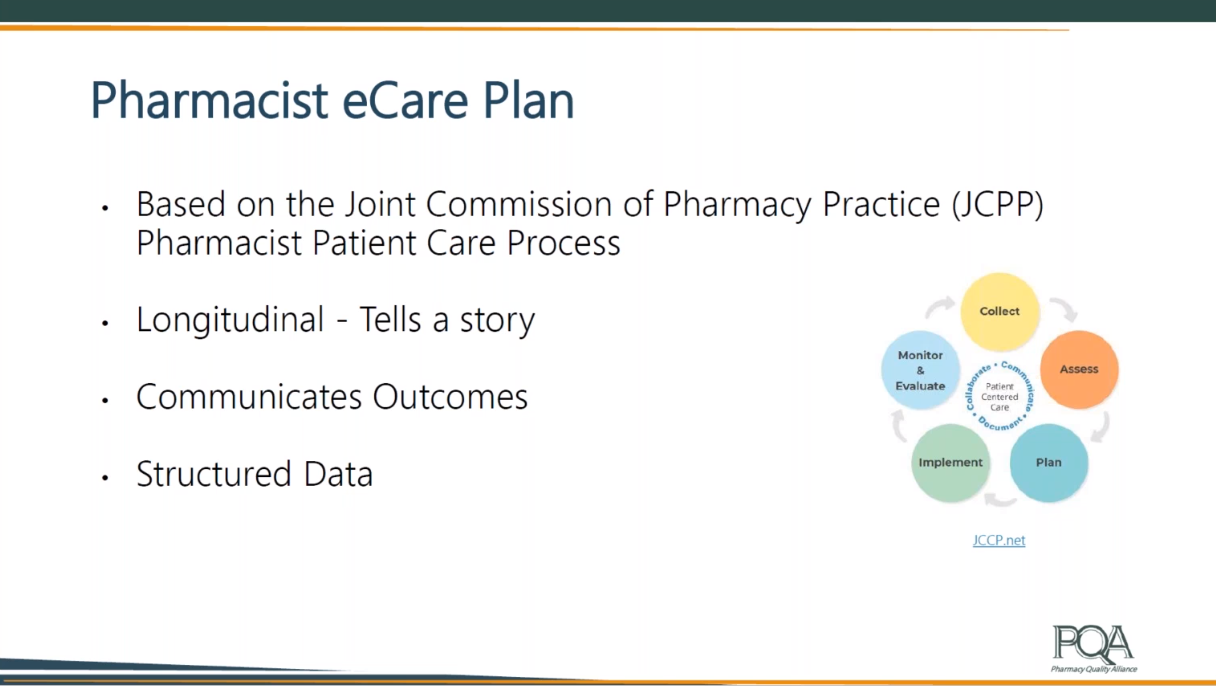The Pharmacist eCare Plan: Improving Data Access and Workflow for High-Quality Care
Josh Howland, Vice President of Clinical Strategy at PioneerRX, provided a presentation on the Pharmacist eCare Plan (Plan) at PQA’s Data and Interoperability Advisory Group (DIAG) meeting on June 22.
This blog provides an overview of Howland’s presentation. You can view a recording of the DIAG meeting and read more about it in a PQA blog, which outlines PQA’s work to address data infrastructure, standards and interoperability.
 Howland provided an overview of the Plan, it’s accomplishments and what’s to come. Howland said the Plan gives providers a robust, longitudinal view of a patient’s care and status, rather than an isolated snapshot.
Howland provided an overview of the Plan, it’s accomplishments and what’s to come. Howland said the Plan gives providers a robust, longitudinal view of a patient’s care and status, rather than an isolated snapshot.
“We’ve been limited historically by claims-based feeds of what we can tell about what’s going on with a patient, Howland said. “Now, pharmacists will be able to share a holistic story of a patient with providers, other pharmacies and clinical networks in an effective way.
At its highest level, the Plan is a tool that allows pharmacies and their staff to document care while using a workflow they’re accustomed to rather than introducing a new program. Technology vendors are actively developing eCare programs that can be embedded within or bolted onto a pharmacy management system or be a completely separate system depending on a pharmacy’s preference.
According to Howland, three major characteristics set the Plan apart:
- It is a longitudinal platform. It tells a story over a period of time from the first time a pharmacist creates a care plan until the patient is no longer visiting that pharmacist.
- It communicates outcomes. Consider the example of measuring adherence through a PDC vs. linking that PDC to decreased A1C on a diabetic patient. The latter is where “the eCare Plan really shines.”
- It is built on structured data. It’s built on data that you can share from one place to another. In theory, the Plan is an international standard, so it could be shared across the planet.
 Rather than just sharing demographics, which are fairly simple to record, the Plan allows the health care industry to share allergies, health conditions, vital signs and labs and more that help to provide a more complete picture of patient health. Moreover, this type of data can often get lost in translation without standard recording processes.
Rather than just sharing demographics, which are fairly simple to record, the Plan allows the health care industry to share allergies, health conditions, vital signs and labs and more that help to provide a more complete picture of patient health. Moreover, this type of data can often get lost in translation without standard recording processes.
“The pharmacy vendors are building this data as they go along, so a pharmacist doesn’t have to always put in the demographics, encounter details, allergies…” Howland said. “Instead we’re compiling data already in the system and turning it into a universal standard.”
Beyond the categories listed above, the Plan is built to share unique information such as goals for outcomes and care coordination. This allows a pharmacist to not only set a goal when creating a care plan, but also document all steps taken to achieve that goal and how successful they were.
As the development of the Plan progresses, Howland looks forward to building out assessments, or a means of recording more in-depth information such as a structured quality of life score or a two-week antibiotic checkup.
To summarize, Howland said a goal of the Plan is that “everybody gets presents” in the form of useful clinical documentation and a mechanism for billing services.
“You're making goals and interventions and tracking the outcomes,” Howland said. “You generate the care plan. You use data standards to exchange it with one place or another. And then everybody gets presents. We're rapidly approaching a world where drugs is a commodity and pharmaceutical services diverge. This gives you the ability to do those other things, like documentation and billing.”
This blog is one in a series highlighting presentations made during the June 22, 2020, meeting of PQA’s Data and Interoperability Advisory Group (DIAG).
